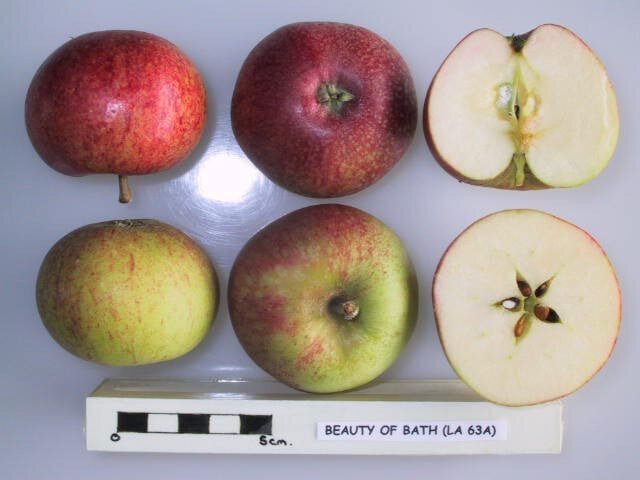Pomiferous
Welcome to the world's most extensive apples (pommes) database.
Information on over 7,000 apples is available here, all carefully researched and provided in a way that is easy to navigate.
Beauty of Bath

type: Dessert, Eating
identification: Small size, sometimes tending to medium. Round but flattened top and bottom. The skin is yellow with pink and often bright red flushes. Sometimes there are small patches of russet. The eye is large and closed, set in a deep and wide, slightly puckered basin. The stem is short and thick, set in a wide, deep cavity.
characteristics: Creamy white flesh, sometimes traces of pink can be seen under the skin. Somewhat tart when picked early, but sweet and flavourful when allowed to ripen fully. It needs to be eaten within a few days of being picked since it tends to become mealy very quickly.
uses: An eating apple, best enjoyed fresh from the tree. Does not store well.
origins: Raised from a seedling at Bailbrook near Bath (Britain) and introduced in 1864.
cultivation: A vigorous, spreading tree, but not cold hardy. Bears fruit on spurs. Takes a long time to start producing, but tends to produce moderate crops annually. Does best with a annual applications of potash.
mutations: Crimson Beauty , Crimson Beauty of Bath , Crimson Beauty of Bath (LARS) , Red Beauty of Bath , Tim's Early
vulnerabilities: Resistant to scab. Sensitive to sulphur treatment.
harvest: Ready for harvest three weeks before the start of the fourth period but often drops fruit before it is ripe.
notes: Named for the town of Bath rather than some other fanciful thoughts involving bathing and beauties.
pollination group: C
pollination peak: 9
ploidism: Diploid. Self fertile.
harvest period: 4
Donate a cider?
©2016-2021 Pomiferous.com. All rights reserved